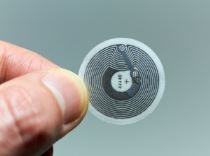 For a couple of years Near Field Communications (NFC) has been pushed by Google and others as the next big thing for smartphones. NFC lets your phone talk to other NFC enabled phones and equipment, including NFC tags that don’t even need a power supply (this capability comes from the RFID heritage that NFC is built on). Right from the beginning two killer applications for NFC were touted. One as a replacement for Bluetooth for things like exchanging contact details and sharing photos—because unlike Bluetooth NFC doesn’t need any pairing or other steps complicating things for users. The real killer application though would be as a digital wallet, i.e. use your phone to pay for smaller purchases, or to confirm (instead of pin codes) credit card transactions. Other frequently cited scenarios are using NFC as a key for your car or house, just like you could use RFID tags today, or as a replacement for QR codes.
For a couple of years Near Field Communications (NFC) has been pushed by Google and others as the next big thing for smartphones. NFC lets your phone talk to other NFC enabled phones and equipment, including NFC tags that don’t even need a power supply (this capability comes from the RFID heritage that NFC is built on). Right from the beginning two killer applications for NFC were touted. One as a replacement for Bluetooth for things like exchanging contact details and sharing photos—because unlike Bluetooth NFC doesn’t need any pairing or other steps complicating things for users. The real killer application though would be as a digital wallet, i.e. use your phone to pay for smaller purchases, or to confirm (instead of pin codes) credit card transactions. Other frequently cited scenarios are using NFC as a key for your car or house, just like you could use RFID tags today, or as a replacement for QR codes.
There has been a lot said about the merits of these consumer applications for NFC, including whether NFC or competing technologies such as Bluetooth Low Energy, is where the future is going. But what about applications in business—what role could NFC play there?
Here at IFS we’ve been looking into just that. We’ve built solutions for a couple of scenarios and prototyped a few more. My view on this is that NFC has a lot of useful applications in a business context. To just mention a few:
- As a replacement for barcodes in the warehouse. Reading an NFC tag is faster, more accurate, and less dependent on light conditions than scanning a barcode. Plus it gives businesses a choice to use inexpensive consumer devices over the rather costly ruggedized scanners. Sure, NFC tags are a little more expensive so you probably won’t put them on the boxes of inexpensive products, but sticking them on warehouse bins (for location scanning, for example) is a no-brainer. This is one of the scenarios we have already implemented in IFS Applications, more specifically in our IFS Scan It app.
- In retail self-pick scenarios. Imagine you’re shopping at IKEA or any other place where you self-pick the goods. Walking around the show floor you find that couch you want for the living room. Instead of having to memorize the isle where you can pick it up later (or fetching one of those little pens and writing it down) you just pull out your phone and scan the NFC tag on the label. This automatically directs you to download the “shopping app” if it’s not on your phone already, and adds the item to your pick list. Once you get to the warehouse section the app shows a map with an optimal pick-route through the isles for all the stuff on your list. At the checkout you simply tap your phone on the till to transfer your pick list—no running around like crazy with the scanner looking for bar codes. You pay and you’re out. It’s a true win-win. A much better experience for you as a shopper, and higher throughput at the checkout for the store. We’ve prototyped this scenario and it works great.
- In service management. A technician can tap his or her phone at a location or on an asset to prove when he arrived on site and thus avoiding any doubts about whether a service level agreement (SLA) was met or not. Or if it is service direct towards consumers (think cable guy), the customer can “tap phones” with the technician to sign off on the job and automatically pop open the satisfaction survey on the customers phone.
- For time and attendance. Instead of the good old punch clock, or more modern digital equivalents, workers could simply tap their phone against a board with different NFC tags for different actions such as “clock out for lunch”, “clock in”, “clock out sick”.
The list could be made much longer. Friends of order will argue that some of these scenarios could be done just as well with RFID. The big difference though is that RFID scanners will remain in the land of expensive stuff bought by companies. It will never make into the hands of billions of people, rendering scenarios like the IKEA and service management ones are a no-go.
NFC though has a good chance of doing just that – ending up in everyone’s hand. There are already plenty of NFC capable Android phones, and several Windows Phones. Still we haven’t seen the breakthrough though and some are even speculating that we never will. Personally I believe that the key deciding factor for NFC’s success is whether Apple incorporates it into the iPhone. There are rumors about NFC in an upcoming iPhone 5S. Are the rumors true? I don’t know, but at least Apple continues to file patent applications related to NFC. That might just be a clue.
Come on Apple—NFC is Good for Business!